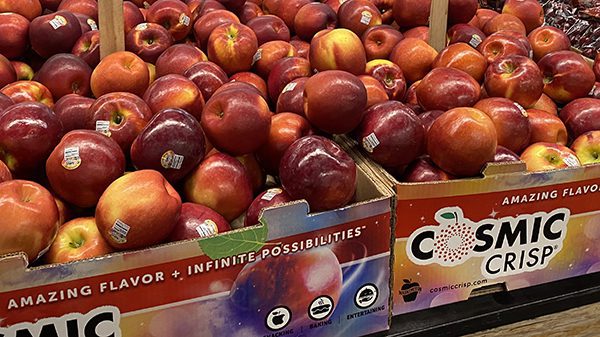Most foods are manufactured and therefore standardized products. If I try a new snack or energy drink and (as often happens) find it loathsome, I can assume that another sample will be more or less the same. One can of Monster is very much like another.
This doesn’t apply to produce, of course. One nectarine may be much sweeter and juicier than the one next to it on the shelf.
Consumers know this: the typical person will not taste one piece of fruit that is off and decide never to buy that kind of fruit again.
All the same, there is what I call the “feel-like factor.”

It was particularly powerful in earlier decades when seasonal availability varied much more than today. If I bought a navel orange early in the season, and it was dry and flavorless, I wouldn’t swear never to buy another navel orange again.
But I found that I just didn’t feel like buying navel oranges next time. Maybe this would last for a couple of weeks, maybe for the entire season.
Is the feel-like factor affecting the favorite child of the apple industry—the Cosmic Crisp? Personally, I have not found this to be the case.
The Cosmic Crisps that I’ve had have all been reliably good. Yet there is some concern about this matter.
Mac Riggan, director of marketing for Chelan Fresh BB #:170403 in Chelan, WA, says there’s “more variability in the quality of the eating experience” with Cosmic Crisp “than I’d expect. The variability kind of shocked me, actually.
“I’m not sure the apple delivered on the perceived expectation,” he adds. “Repeat sales are not what we had thought be.”
The reason? With Honeycrisp varieties and their derivatives, there are “certain conditions where they grow better than others,” Riggan continues. “That’s a fact. How can you tell a grower, ‘You don’t have the right spot?’ You hope that the apple can bridge the gap,”
Riggan continues, “The variability of the fruit has as much to do with where it’s grown as how it’s grown.”
In short, “we’re growing the [Cosmic Crisp] fruit in areas where we shouldn’t,” says Riggan. He explains that the variety was developed by Washington State University, so it has to be made available to all growers in the state, regardless of whether their land is suitable or not.
With patented varieties—such as the SugarBee, jointly owned by Chelan and Gebber Farms—the owners have more control, being able to license them to growers who have the right conditions, Riggan notes.
“It’s not a panic situation,” Riggan says. “There are vintage crops from year to year. This wasn’t a vintage year, but it was a good eating year.”
Economics will play a large role in determining the success of the Cosmic Crisp.
“Cosmic Crisp came out with a splash but hasn’t created a lot of fanfare,” Riggan says. “These apples are expensive to grow; you want to get as much as possible out of your investment.”
Riggan does not see current prices justifying that. Prices last year averaged $2.63 a pound, down 46 cents from the previous, first season. I myself paid $2.99 a pound this week at the Jewel-Osco in Wheaton, IL, just down the street from Blue Book headquarters.
Other sources, including Produce Blue Book, indicate strong growth for Cosmic Crisp: “In the last quarter alone, Cosmic Crisp brought in $15 million . . . Cosmic Crisp was up 48% in dollars, and 74% in pounds in the 3 months ending February 27.”
The Cosmic Crisp world is currently launching a major marketing push. Kathryn Grandy, chief marketing officer of Proprietary Variety Management, in Yakima, WA, which markets the variety, says that her company is in negotiations with several national food chains to ensure that every supermarket in the nation will be featuring Cosmic Crisps by 2022.
Marketing and promotion work.
But my personal guess is that the Cosmic Crisp, though a fine apple, is not so superior that consumers are likely to pay a premium for it over, say, Honeycrisp.



